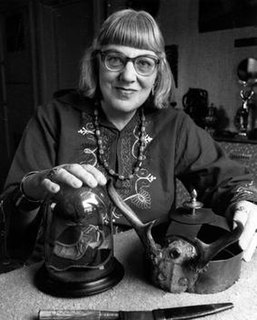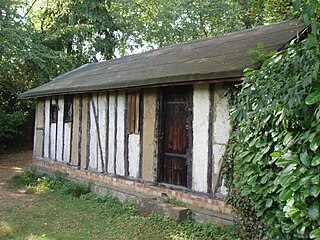
Gardnerian Wicca, or Gardnerian witchcraft, is a tradition in the neopagan religion of Wicca, whose members can trace initiatory descent from Gerald Gardner. The tradition is itself named after Gardner (1884–1964), a British civil servant and amateur scholar of magic. The term "Gardnerian" was probably coined by the founder of Cochranian Witchcraft, Robert Cochrane in the 1950s or 60s, who himself left that tradition to found his own.

The Horned God is one of the two primary deities found in Wicca and some related forms of Neopaganism. The term Horned God itself predates Wicca, and is an early 20th-century syncretic term for a horned or antlered anthropomorphic god partly based on historical horned deities.

Skyclad refers to ritual nudity in Wicca and Modern Paganism. Some groups, or Traditions, perform most or all of their rituals skyclad. Whilst nudity and the practice of witchcraft have long been associated in the visual arts, this contemporary ritual nudity is typically attributed to either the influence of Gerald Gardner or to a passage from Charles Godfrey Leland's 1899 book Aradia, or the Gospel of the Witches, and as such is mainly attributed to the Gardnerian and Aradian covens.

Wicca is a modern Pagan religion. Scholars of religion categorise it as both a new religious movement and as part of the occultist stream of Western esotericism. It was developed in England during the first half of the 20th century and was introduced to the public in 1954 by Gerald Gardner, a retired British civil servant. Wicca draws upon a diverse set of ancient pagan and 20th-century hermetic motifs for its theological structure and ritual practices.
The Wiccan Rede is a statement that provides the key moral system in the neopagan religion of Wicca and certain other related witchcraft-based faiths. A common form of the Rede is An ye harm none, do what ye will which was taken from a longer poem also titled the Wiccan Rede.
Aradia is one of the principal figures in the American folklorist Charles Godfrey Leland's 1899 work Aradia, or the Gospel of the Witches, which he believed to be a genuine religious text used by a group of pagan witches in Tuscany, a claim that has subsequently been disputed by other folklorists and historians. In Leland's Gospel, Aradia is portrayed as a messiah who was sent to Earth in order to teach the oppressed peasants how to perform witchcraft to use against the Roman Catholic Church and the upper classes.

A Book of Shadows is a book containing religious text and instructions for magical rituals found within the Neopagan religion of Wicca. Since its conception in the 1970s, it has made its way into many pagan practices and paths. The most famous Book of Shadows was created by the pioneering Wiccan Gerald Gardner sometime in the late 1940s or early 1950s, and which he utilised first in his Bricket Wood coven and then in other covens which he founded in following decades. The Book of Shadows is also used by other Wiccan traditions, such as Alexandrian Wicca and Mohsianism, and with the rise of books teaching people how to begin following non-initiatory Wicca in the 1970s onward, the idea of the Book of Shadows was then further propagated amongst solitary practitioners unconnected to earlier, initiatory traditions.
Stregheria is the root form of Witchcraft originating in Southern Europe, but also includes Italian American witchcraft. Stregheria is sometimes referred to as La Vecchia Religione. The word stregheria is an archaic Italian word for "witchcraft", the most used and modern Italian word being stregoneria. "Stregoneria Italiana" is a form of stregoneria that took hold of southern Europe before the Catholic church forced practitioners to conform. Stregheria is rooted in folk magic having little if any relationship to other forms of Witchcraft.

Doreen Edith Dominy Valiente was an English Wiccan who was responsible for writing much of the early religious liturgy within the tradition of Gardnerian Wicca. An author and poet, she also published five books dealing with Wicca and related esoteric subjects.

A craft name, also referred to as magical name, is a secondary religious name often adopted by practitioners of Wicca and other forms of Neopagan witchcraft or magic. Craft names may be adopted as a means of protecting one's privacy, as an expression of religious devotion, or as a part of an initiation ritual. It may also be used as a protective method, as it is believed by some that one's "true name" can be used as a taglock, to identify that person for the purpose of magical activities.

Aradia, or the Gospel of the Witches is a book composed by the American folklorist Charles Godfrey Leland that was published in 1899. It contains what he believed was the religious text of a group of pagan witches in Tuscany, Italy that documented their beliefs and rituals, although various historians and folklorists have disputed the existence of such a group. In the 20th century, the book was very influential in the development of the contemporary Pagan religion of Wicca.
Drawing down the Moon is a central ritual in many contemporary Wiccan traditions. During the ritual, a coven's High Priestess enters a trance and requests that the Goddess or Triple Goddess, symbolized by the Moon, enter her body and speak through her. The High Priestess may be aided by the High Priest, who invokes the spirit of the Goddess. During her trance, the Goddess is supposed to speak through the High Priestess.

Philip Heselton is a retired British Conservation Officer, a Wiccan initiate, and a writer on the subjects of Wicca, Paganism and Earth mysteries. He is best known for two books, Wiccan Roots: Gerald Gardner and the Modern Witchcraft Revival and Gerald Gardner and the Cauldron of Inspiration, which gather historical evidence surrounding the New Forest coven and the origins of Gardnerian Wicca.
The history of Wicca documents the rise of the Neopagan religion of Wicca and related witchcraft-based Neopagan religions. Wicca originated in the early twentieth century, when it developed amongst secretive covens in England who were basing their religious beliefs and practices upon what they read of the historical Witch-Cult in the works of such writers as Margaret Murray. It was subsequently popularized in the 1950s by a number of figures, in particular Gerald Gardner, who claimed to have been initiated into the Craft – as Wicca is often known – by the New Forest coven in 1939. Gardner's form of Wicca, the Gardnerian tradition, was spread by both him and his followers like the High Priestesses Doreen Valiente, Patricia Crowther and Eleanor Bone into other parts of the British Isles, and also into other, predominantly English-speaking, countries across the world. In the 1960s, new figures arose in Britain who popularized their own forms of the religion, including Robert Cochrane, Sybil Leek and Alex Sanders, and organizations began to be formed to propagate it, such as the Witchcraft Research Association. It was during this decade that the faith was transported to the United States, where it was further adapted into new traditions such as Feri, 1734 and Dianic Wicca in the ensuing decades, and where organizations such as the Covenant of the Goddess were formed.

Wiccan views of divinity are generally theistic, and revolve around a Goddess and a Horned God, thereby being generally dualistic. In traditional Wicca, as expressed in the writings of Gerald Gardner and Doreen Valiente, the emphasis is on the theme of divine gender polarity, and the God and Goddess are regarded as equal and opposite divine cosmic forces. In some newer forms of Wicca, such as feminist or Dianic Wicca, the Goddess is given primacy or even exclusivity. In some forms of traditional witchcraft that share a similar duotheistic theology, the Horned God is given precedence over the Goddess.

Wiccan morality is largely expressed in the Wiccan Rede: 'An' it harm none, do what ye will' - old-fashioned language for 'as long as you aren't harming anyone, do as you wish'. While this could be interpreted to mean "do no harm at all," it is usually interpreted as a declaration of the freedom to act, along with the necessity of thinking through and taking responsibility for the consequences of one's actions.

In the neopagan religion of Wicca a range of magical tools are used in ritual practice. Each of these tools has different uses and associations and are commonly used at an altar, inside a magic circle.

The Bricket Wood coven, or Hertfordshire coven is a coven of Gardnerian witches founded in the 1940s by Gerald Gardner. It is notable for being the first coven in the Gardnerian line, though having its supposed origins in the pre-Gardnerian New Forest coven. The coven formed after Gardner bought the Fiveacres Country Club, a naturist club in the village of Bricket Wood, Hertfordshire, southern England, and met within the club's grounds. It played a significant part in the history of the neopagan religion of Wicca.

Raymond Howard was an English practitioner of the modern Pagan new religious movement of Wicca. He promoted his tradition, known as the Coven of Atho, through a correspondence course established in the early part of the 1960s.
In Modern English, the term Wicca refers to Wicca, the religion of contemporary Pagan Witchcraft. It is used within the Pagan community under competing definitions. One refers to the entirety of the Pagan Witchcraft movement, while the other refers explicitly to traditions included in what is now called British Traditional Wicca.














